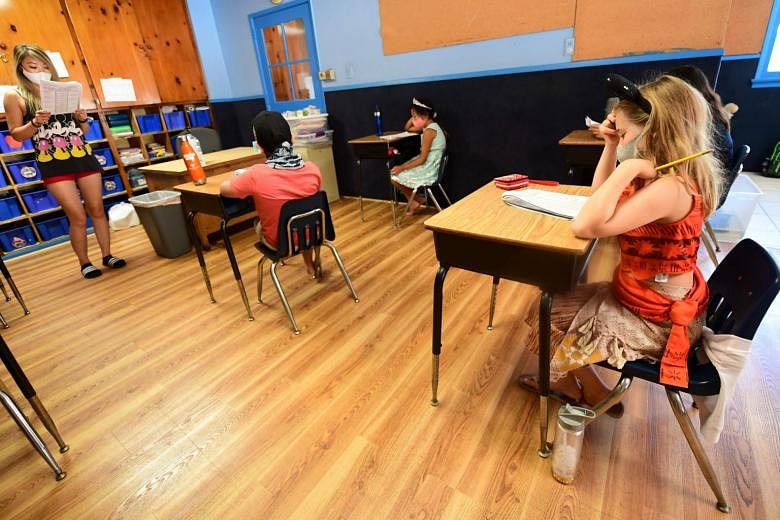WASHINGTON - It is a cruel dilemma - open schools and risk the health of children, their teachers and their families, or keep them closed and have children suffer from lack of social interaction, impaired education, and in many cases, food deprivation and risk of abuse at home.
It does not help that whether or not to reopen schools, and how to do so safely, has become the United States' newest political battleground.
On Thursday (July 9), White House spokesman Kayleigh McEnany, in a customarily combative media briefing, made a strong pitch for opening schools as usual in the fall.
For students of colour especially, "school closings create problems even more urgent than the interruption of their educations", she said, citing conclusions by the National Association for the Advancement of Colored People (NAACP).
Certainly there are concerns about domestic violence and child abuse with children cooped up at home for a prolonged period, sometimes in inherently risky environments. The provision of a meal at school is a critical part of the lives of low-income groups as well.
"Schools also serve as a community nexus for food and for housing," Ms McEnany noted.
The American Academy of Pediatrics has said that keeping students at home can lead to social isolation, abuse and depression, and prevent schools from identifying learning deficits and other issues.
This applies in other countries as well. An open letter this month signed by more than 1,500 members of the United Kingdom's Royal College of Paediatrics and Child Health stated that continued closure of schools risks "scarring the life chances of a generation of young people".
The White House's pressure came as confusion reigned over the Centers for Disease Control and Prevention (CDC) guidelines for schools. In many cases, these guidelines would cost schools significant money to implement.
Spacing desks is one thing, but ensuring distancing between students outside the classroom is another.
Earlier in the week, President Donald Trump, said he disagreed with the CDC's guidelines, and insisted that the Democratic Party wants to keep schools shut to make him look bad for his handling of the pandemic.
"They think it's going to be good for them politically, so they keep the schools closed," Mr Trump said on Tuesday at a White House discussion on school plans.
"No way. We're very much going to put pressure on governors and everybody else to open the schools."
CDC director Robert Redfield at the same event, acquiesced, saying: "It's clear that the greater risk to our society is to have these schools close."
"Nothing would cause me greater sadness than to see any school district or school use our guidance as a reason not to reopen," he said.
At an event on Thursday, the President doubled down, saying: "Germany, Norway, so many countries right now, they're open. The schools are open and they're doing just fine, and they're opening in the fall. So we have to get our schools open.
"Denmark, Sweden. We have to get our schools open and stop this political nonsense."
The White House also argued that children are less susceptible to the virus.
"The bottom line is that the impacts of Covid-19 on children is minimal, or very low, compared to other age groups," Ms McEnany insisted.
Several studies have in fact found that generally, people under age 18 are between one-third and one-half as likely as adults to contract the virus.
The risk seems lowest for the youngest children.
The counter argument is that the pandemic is out of control in the US, and while the virus does not affect children as much as adults, they are far from immune - in recent days two 11-year-olds have died in Florida from Covid-19 - and children can spread the virus to older people in school and at home.
Several states have been reporting record numbers of hospitalisations, and deaths are also creeping up again after a period of decline or stability.
As of Thursday evening, the US had over 3.1 million infections and over 133,000 deaths.
Politics, on top of the US' decentralised structure coupled with scepticism of government and of science, and conflicting and mixed messages on wearing of masks, has severely hampered the country's response, even as President Trump has insisted that the situation could have been worse.
In an interview with the FiveThirtyEight website on Thursday, the government's top infectious diseases expert, Dr Anthony Fauci, acknowledged as much.
"It's just unfortunate, but it is what it is," he said.
"And you know, from experience historically, that when you don't have unanimity in an approach to something, you're not as effective in how you handle it."
"So I think you'd have to make the assumption that if there wasn't such divisiveness, that we would have a more coordinated approach."
Parts of the US, like New York, are doing well, Dr Fauci said.
"But as a country, when you compare us to other countries, I don't think you can say we're doing great. I mean, we're just not."












